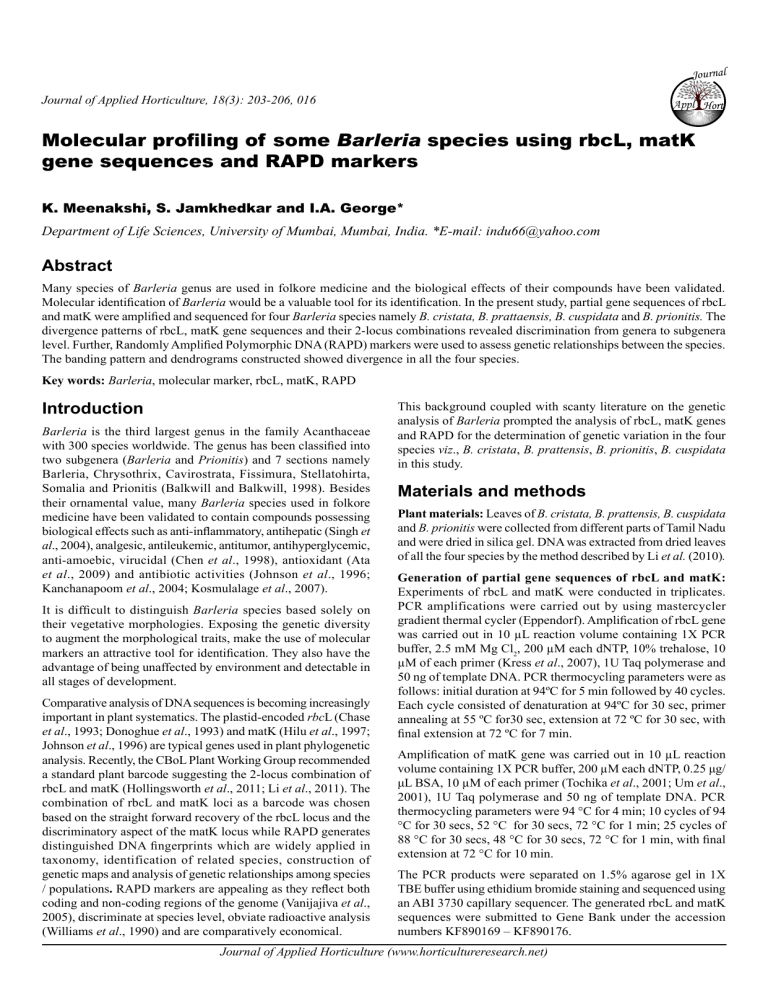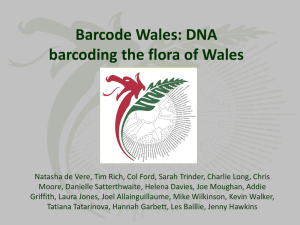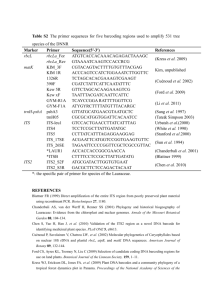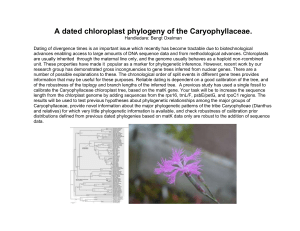
Journal Journal of Applied Horticulture, 18(3): 203-206, 016 Appl Molecular profiling of some Barleria species using rbcL, matK gene sequences and RAPD markers K. Meenakshi, S. Jamkhedkar and I.A. George* Department of Life Sciences, University of Mumbai, Mumbai, India. *E-mail: indu66@yahoo.com Abstract Many species of Barleria genus are used in folkore medicine and the biological effects of their compounds have been validated. Molecular identification of Barleria would be a valuable tool for its identification. In the present study, partial gene sequences of rbcL and matK were amplified and sequenced for four Barleria species namely B. cristata, B. prattaensis, B. cuspidata and B. prionitis. The divergence patterns of rbcL, matK gene sequences and their 2-locus combinations revealed discrimination from genera to subgenera level. Further, Randomly Amplified Polymorphic DNA (RAPD) markers were used to assess genetic relationships between the species. The banding pattern and dendrograms constructed showed divergence in all the four species. Key words: Barleria, molecular marker, rbcL, matK, RAPD Introduction Barleria is the third largest genus in the family Acanthaceae with 300 species worldwide. The genus has been classified into two subgenera (Barleria and Prionitis) and 7 sections namely Barleria, Chrysothrix, Cavirostrata, Fissimura, Stellatohirta, Somalia and Prionitis (Balkwill and Balkwill, 1998). Besides their ornamental value, many Barleria species used in folkore medicine have been validated to contain compounds possessing biological effects such as anti-inflammatory, antihepatic (Singh et al., 2004), analgesic, antileukemic, antitumor, antihyperglycemic, anti-amoebic, virucidal (Chen et al., 1998), antioxidant (Ata et al., 2009) and antibiotic activities (Johnson et al., 1996; Kanchanapoom et al., 2004; Kosmulalage et al., 2007). It is difficult to distinguish Barleria species based solely on their vegetative morphologies. Exposing the genetic diversity to augment the morphological traits, make the use of molecular markers an attractive tool for identification. They also have the advantage of being unaffected by environment and detectable in all stages of development. Comparative analysis of DNA sequences is becoming increasingly important in plant systematics. The plastid-encoded rbcL (Chase et al., 1993; Donoghue et al., 1993) and matK (Hilu et al., 1997; Johnson et al., 1996) are typical genes used in plant phylogenetic analysis. Recently, the CBoL Plant Working Group recommended a standard plant barcode suggesting the 2-locus combination of rbcL and matK (Hollingsworth et al., 2011; Li et al., 2011). The combination of rbcL and matK loci as a barcode was chosen based on the straight forward recovery of the rbcL locus and the discriminatory aspect of the matK locus while RAPD generates distinguished DNA fingerprints which are widely applied in taxonomy, identification of related species, construction of genetic maps and analysis of genetic relationships among species / populations. RAPD markers are appealing as they reflect both coding and non-coding regions of the genome (Vanijajiva et al., 2005), discriminate at species level, obviate radioactive analysis (Williams et al., 1990) and are comparatively economical. This background coupled with scanty literature on the genetic analysis of Barleria prompted the analysis of rbcL, matK genes and RAPD for the determination of genetic variation in the four species viz., B. cristata, B. prattensis, B. prionitis, B. cuspidata in this study. Materials and methods Plant materials: Leaves of B. cristata, B. prattensis, B. cuspidata and B. prionitis were collected from different parts of Tamil Nadu and were dried in silica gel. DNA was extracted from dried leaves of all the four species by the method described by Li et al. (2010). Generation of partial gene sequences of rbcL and matK: Experiments of rbcL and matK were conducted in triplicates. PCR amplifications were carried out by using mastercycler gradient thermal cycler (Eppendorf). Amplification of rbcL gene was carried out in 10 µL reaction volume containing 1X PCR buffer, 2.5 mM Mg Cl2, 200 µM each dNTP, 10% trehalose, 10 µM of each primer (Kress et al., 2007), 1U Taq polymerase and 50 ng of template DNA. PCR thermocycling parameters were as follows: initial duration at 94ºC for 5 min followed by 40 cycles. Each cycle consisted of denaturation at 94ºC for 30 sec, primer annealing at 55 ºC for30 sec, extension at 72 ºC for 30 sec, with final extension at 72 ºC for 7 min. Amplification of matK gene was carried out in 10 µL reaction volume containing 1X PCR buffer, 200 µM each dNTP, 0.25 μg/ μL BSA, 10 µM of each primer (Tochika et al., 2001; Um et al., 2001), 1U Taq polymerase and 50 ng of template DNA. PCR thermocycling parameters were 94 °C for 4 min; 10 cycles of 94 °C for 30 secs, 52 °C for 30 secs, 72 °C for 1 min; 25 cycles of 88 °C for 30 secs, 48 °C for 30 secs, 72 °C for 1 min, with final extension at 72 °C for 10 min. The PCR products were separated on 1.5% agarose gel in 1X TBE buffer using ethidium bromide staining and sequenced using an ABI 3730 capillary sequencer. The generated rbcL and matK sequences were submitted to Gene Bank under the accession numbers KF890169 – KF890176. Journal of Applied Horticulture (www.horticultureresearch.net) 204 Profiling of some Barleria species using rbcL, matK gene sequences and RAPD markers Sequences were aligned using ClustalW. Pair-wise evolutionary distance among generated gene sequences was determined by the Kimura 2-Parameter method using the software program MEGA 3.117. Maximum Likelihood (ML) tree was constructed and bootstrap analysis was carried out using 1000 pseudoreplications. Hibiscus rosa-sinensis sequences were used as outgroup and they were obtained from NCBI GenBank (Acc.Nos: JX887624 and JQ412251). RAPD Analysis: A set of 37 random decamer primers from various Operon kits (Operon Technologies Inc., Almeda, CA, USA) were used for RAPD amplification. Amplification reactions (10 μL final volume) contained 50 ng of genomic DNA, 0.5 μM 10-mer primer, 10 mM Tris- HCl pH 9.0, 150 mM KCl, 2.5 mM MgCl2, 2.5 μM dNTPs and 0.5 units Taq polymerase. Amplification was performed in a programmable thermocycler (Model-PTC100: MJ research Inc., Waltham MA, USA) with 45 cycles of 94 ºC for 30 sec, 35 ºC for 1 min, and 72 ºC for 2 min with an initial denaturation at 95 ºC for 5 min and a final extension at 72 ºC for 5 min. Then the amplified products were separated electrophoretically in a 1.5% (w/v) agarose gel. The gels were viewed and photographed on UV transilluminator. Reproducible DNA fragments were scored as discrete variables, using 1 for the presence of bands and 0 for the absence of bands. The scored RAPD markers were converted into a binomial (0/1) matrix. All experiments were conducted in triplicate. POPGEN v32 tool (Yeh et al., 1997) was used to calculate Nei and Li’s genetic distance and to construct a dendrogram using UPGMA method. Results Analysis using rbcL, matK and rbcL + matK sequences: Pair-wise evolutionary distances, using all the 3 markers rbcL, matK genes and 2 locus combination of rbcL + matK, were generated (Table 1-3). Insertions, deletions or stop codons were not observed in any sequence under study. Conserved, Variable and Parsimony informative sites, overall mean divergence, Table 1. Genetic distances of Barleria species based on rbcL gene sequences 1 2 3 4 1. B. cristata 2. B. prattensis 0.000 3. B. cuspidata 0.009 0.009 4. B. prionitis 0.009 0.009 0.000 5. Hibiscus rosa-sinensis 0.097 0.097 0.095 0.095 Table 2. Genetic distances of Barleria species based on matK gene sequences 1 2 3 4 1. B. cristata 0.001 2. B. prattensis 0.034 0.033 3. B. cuspidata 0.034 0.033 0.000 4. B. prionitis 0.660 0.664 0.641 0.641 5. Hibiscus rosa-sinensis Table 3. Genetic distances of Barleria species based on 2- locus (rbcL+matK) combination 1 2 3 4 1. B. cristata 0.001 2. B. prattensis 0.025 0.027 3. B. cuspidata 0.025 0.027 0.000 4. B. prionitis 1.916 1.914 1.872 1.872 5. Hibiscus rosa-sinensis transition/transversion bias and G+C content are shown in Table 4. The transition/transversion ratios and G+C content showed a ranking order correlation in all the three markers, rbcL, matK and their 2 locus combination, respectively. The majority of changes were transitional changes. The genetic distance analysis of all the three markers have not shown divergence at species level but revealed a good variation at subgenera level. The cluster analysis using these 3 markers indicated that the four Barleria species in the present study were grouped into 2 major clusters (Fig. 1-3). First cluster included B. cristata and B. prattensis and the second cluster B. cuspidata and B. prionitis. All the clusters were supported by high bootstrap values. RAPD analysis: Operon primers (37 random primers) were used to probe genetic relationship of B .cristata, B. prattensis, B. prionitis, B. cuspidata of which 6 primers namely OP-AO18, OP-E1, OP-E4, OP-J19, OP-J20, OP-F12 yielded good and reproducible polymorphic bands. These 6 primers produced a total of 27 DNA fragments of which 26 (96.30%) fragments showed polymorphisms in one or more genotypes (Table 5 and Fig. 4). The total number of bands for each primer ranged from 2 (OPE1, OP-AO18) to 6 (OP-J19, OP-F12). The highest number of polymorphisms was observed with primers OP-J19 and OPF12. The molecular phylogeny tree based on Nei and Li genetic distance (Table 6) of RAPD markers was constructed using UPGMA method (Fig. 5). Table 4. Overall observations made after the alignment and pairwise genetic analysis of rbcL, matK genes and 2 locus combination of rbcL + matK Results obtained after alignment rbcL matK rbcL+matK and pair wise genetic analysis combination Total consensus length 695 825 1562 Conserved sites 643 (92.51 %) 648 (78.54 %) Variable sites 1295 (82.90%) 52 176 228 (7.48 %) (21.33 %) (14.59 %) Parsimony informative sites 5 (0.71 %) 22 (2.6 %) 27 (1.7 %) Overall mean divergence 4.2% 76.8% 27.4% Transition/transversion bias 1.83 1.28 1.36 G+C content 43.786 % 35.4 % 39.076 % Table 5. Details of the primers producing polymorphic bands. Sl.No Primer Total number of bands Polymorphic bands 3 (11.11%) 3 (11.53%) 1 OP-AO18 2 OP-E1 2 (7.40%) 2 (7.69%)) 3 OP-E4 6 (22.22%) 6 (23.07%) 4 OP-J19 6 (22.22%) 6 (23.07%) 5 OP-J20 4 (14.81%) 3 (11.53%) 6 OP-F12 6 (22.22%) 6 (23.07%) Table 6. Nei and Li genetic distance B. cristata B. cristata B. prattensis B. prionitis B. cuspidata **** 0.6296 0.5185 0.4815 B. prattensis 0.4626 **** 0.3704 0.2593 B. prionitis 0.6568 0.9933 **** 0.5185 B. cuspidata 0.7309 1.3499 0.6568 **** Nei’s genetic identity (above diagonal) and genetic distance (below diagonal) Journal of Applied Horticulture (www.horticultureresearch.net) Profiling of some Barleria species using rbcL, matK gene sequences and RAPD markers 205 Fig. 1. Maximum Likelihood Tree constructed using rbcL sequences Fig. 2. Maximum Likelihood Tree constructed using matK sequences Fig. 3. Maximum Likelihood Tree constructed using 2- locus (rbcL+matK) combination B. cris B. prat B. prio B. cusp Marker Fig. 5. Dendrogram based on Nei’s genetic distance based on UPGMA method the two sections: B. cristata and B. prattensis (Barleria section), B. cuspidata and B. prionitis (Prionitis section) were observed to be 0.4626 and 0.6568, respectively. Discussion Fig. 4. RAPD products obtained by PCR amplification of DNA isolated from B. cristata, B. prattensis, B. prionitis, B. cuspidata, respectively using random primers OP-E4, OP-J19, OP-F12. B. cris = B. cristata; B. prat = B. prattensis; B. prio = B. prionitis; B. cusP = B. cuspidata, Marker = 100bp marker The value of genetic distance ranged from 0.4626 to 1.3499 while genetic identity ranged from 0.2593 and 0.5185. The cluster analysis grouped the four Barleria species into 2 major clusters; B. cristata and B. prattensis were in one cluster, B. prionitis and B. cuspidata were in another cluster. Nei’s genetic distance of This is the first attempt to use molecular markers to investigate genetic relationships of Barleria species. The rbcL, matK and their combinations as markers discriminated Barleria to its subgenera level albeit at very low pairwise percentages. The combination of two loci promises a higher universality and the greatest ability to differentiate species rather than the single locus barcode. Additionally, transition/transversion ratio is high in rbcL gene due to high number of transitions and it is less in matK gene due to high number of transversions (Oluwatoyin et al., 2009) when compared to rbcL gene. This ratio obtained in the present Journal of Applied Horticulture (www.horticultureresearch.net) 206 Profiling of some Barleria species using rbcL, matK gene sequences and RAPD markers investigation falls between the expected value of 2.0 which indicates relatively recently diverged sequences but exceeds the value of 0.4 which denotes a highly substitution-saturated sequences (Holmquist, 1983). The RAPD analysis also confirmed the results as obtained by rbcL, matK and their combination markers. Furthermore, discrimination at species level was also possible using RAPD marker. Thus the RAPD technique is a competent method for identification of Barleria species just as successfully as in other medicinal and ornamental plants (De Benedetti et al., 2001; Shinde et al., 2007). Hence the present study may serve as a reference point for future examinations of the genetic variation within populations of Barleria species. Acknowledgement We are grateful to DST, Government of India, for their financial support to Ms. Meenakshi K through the DST INSPIRE – AORC scheme and RGCB, Trivandrum for technical support. References Ata, A., K.S. Kalhari and R. Samarasekera, 2009. Chemical constituents of Barleria prionitis and their enzyme inhibitory and free radical scavenging activities. Phytochem. Lett., 2: 37-40. Balkwill, M.J. and K.A. Balkwill, 1998. Preliminary analysis of distribution patterns in a large, pantropical genus, Barleria L. (Acanthaceae). J. Biogeogr., 25: 95-110. CBoL Plant Working Group, 2009. A DNA barcode for land plants. PNAS., 106:12794-12797. Chase, M.W., D.E. Soltis, R.G. Olmstead, D. Morgan and D. Les, 1993. Phylogenetics of seed plants: An analysis of nucleotide sequences from the plastid gene rbcL. Ann. Missouri Bot. Gard., 80: 528-580. Chen, J.L., P. Blanc, C.A. Stoddart, M. Bogan and E.J. Rozhon, 1998. New iridoids from the medicinal plant Barleria prionitis with potent activity against respiratory syncytial virus. J. Nat. Prod., 61: 1295-1297. De Benedetti, L., A. Mercuri, S. Bruna and G. Burchi, 2001. Genotype identification of ornamental species by RAPD analysis. Acta Hort., 546: 391-394. Donoghue, M.J., R.G. Olmstead, J.F. Smith and J.D. Palmer, 1993. Phylogenetic relationships of Dipsacales based on rbcL sequences. Ann. Missouri Bot. Gard., 79: 333-345. Hilu, K.W. and H. Liang, 1997. The matK gene: sequences variation and application in plant systematics. Amer. J. Bot., 84: 830-839. Hollingsworth, P.M., S.W. Graham and D.P. Little, 2011. Choosing and using a plant DNA barcode. <http://journals.plos.org/plosone/ article?id=10.1371/journal.pone.0019254> Holmquist, R. 1983. Transitions and transversion in evolutionary descent: an approach to understanding. J. Mol. Evo., 19: 134-144. Johnson, L.A., J.L. Schultz, D.E. Soltis and P.S. Soltis, 1996. Monophyly and generic relationships of Polemoniaceae based on matK sequences. Amer. J. Bot., 83: 1207-1224. Kanchanapoom, T., P. Noiarsa, S. Ruchirawat, R. Kasai and H. Otsuka, 2004. Phenylethanoid and iridoid glycosides from the Thai medicinal plant, Barleria strigosa. Chem. Pharm. Bul., 52: 612-614. Kosmulalage, K.S., S. Zahid, C.C. Udenigwe, S. Akhtar, A. Ata and R. Samarasekera., 2007. Glutathione S-transferase, acetylcholinesterase inhibitory and antibacterial activities of chemical constituents of Barleria prionitis. Zeitschrift für Naturforschung, 62b: 580-586. Kress, W.J. and D.L. Erickson, 2007. A two-locus global DNA barcode for land plants: The coding rbcL gene complements the non-coding trnH- psbA spacer region. <http://journals.plos.org/plosone/ article?id=10.1371/journal.pone.0000508> Li, F.W., L.Y. Kuo, C.J. Rothfels, A. Ebihara, W.L. Chiou, M.D. Windham and K.M. Pryer, 2011. rbcL and matK earn two thumbs up as the core DNA barcode for Ferns. <http://journals.plos.org/plosone/ article?id=10.1371/journal.pone.0026597> Li Li., Jian Feng Li and Jen sheen, 2010. Protocol: a rapid and economical procedure for purification of plasmid or plant DNA with diverse applications in plant biology. Plant Methods, 6: 1. Oluwatoyin, T.O. and Mark Chase, 2009. Phylogenetic analyses of Amaranthaceae based on matK DNA sequence data with emphasis on West African Species. Turk. J. Bot., 33: 153-161. Shinde, V.M., K. Dhalwal, K.R. Mahadik and K.S. Joshi, 2007. RAPD analysis for determination of components in herbal medicine. Evid. Based Compl. and Alt. Med., 4: 21-23. Singh, B., B.K. Chandan, N. Sharma, S. Singh, S.C. Taneja and A. Prabhakar, 2004. A novel lead for hepatic disorders from Barleria prionitis Linn. Indian J. Pharmacol., 36: 114-115. Tochika-Komatsu, Y., I. Asaka and I. Ii, 2001. A random amplified polymorphic DNA (RAPD) primer to assist the identification of a selected strain, aizu K-111 of Panax ginseng and the sequence amplified. Biol. Pharm. Bul., 24: 1210-1213. Um, J.Y., H.S. Chung, M.S. Kim and H.J. Na, 2001. Molecular authentication of Panax ginseng species by RAPD analysis and PCR-RFLP. Biol. Pharm. Bul., 24: 872-875. Vanijajiva, O., P. Sirirugsa and W. Suvachittanont, 2005. Confirmation of relationships among Boesenbergia (Zingiberaceae) and related genera by RAPD. Biochem. Syst. Ecol., 33: 159-170. Williams, J.G.K., A.R. Kubelik, K.J. Livak, J.A. Rafalski and S.V. Tingey, 1990. DNA polymorphisms amplified by arbitrary primers are useful as genetic markers. Nucleic Acids Res., 18: 6531-6535. Yeh, F.C. and T.J.B. Boyle, 1997. Population genetic analysis of codominant and dominant markers and quantitative traits. Belgian J. Bot., 129: 157. Received: March, 2016; Revised: March, 2016; Accepted: April, 2016 Journal of Applied Horticulture (www.horticultureresearch.net)





